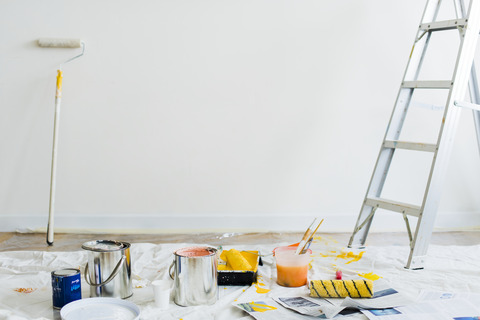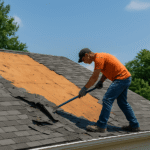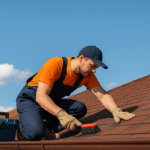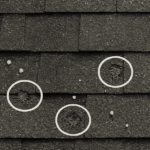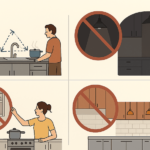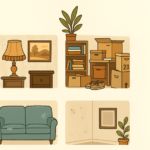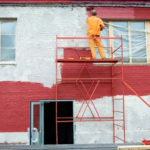When it comes to giving your home a new look, painting is the easiest & quickest option. Whether you want to remodel your living room or the exterior, paint plays a crucial role. But did you know that interior and exterior painting services are not the same?
Each type of painting has a different process, materials, and challenges. Besides, the environment, surface types, and durability requirements all affect the painting process. Hence, in this blog, we’ve discussed the ten differences between interior and interior painting.
1. Paint Types and Formulation
Homeowners often make the mistake of choosing the right paint for both interior & exterior. Interior paint is designed for indoor spaces where temperature and weather changes are minimal. Exterior paint, on the other hand, must withstand harsh outdoor conditions.
Interior paints are made with low-VOC (volatile organic compounds) formulas to reduce odors and maintain indoor air quality. Although they are durable, they can’t withstand extreme weather conditions.
Exterior paints contain additives that protect against UV rays, moisture, and temperature changes. These paints have strong bonding properties to stick to surfaces like wood, brick, and stucco. That’s why they can also resist cracking, peeling, and fading over time.
2. Durability and Protection
Since exterior walls face constant exposure to sun, rain, and wind, exterior paint must be more durable than interior paint. Interior paints are designed for easy cleaning and resistance to scuffs, stains, and everyday wear and tear. Paints with a satin or semi-gloss finish are commonly used in high-traffic areas like kitchens and bathrooms.
Exterior paint must resist cracking, mold growth, and fading due to weather exposure. It has more flexible resins that help it expand and contract with temperature changes, preventing peeling and chipping.
3. Surface Preparation
Proper preparation ensures the paint remains well and lasts longer. The preparation for interior and exterior surfaces is quite different.
Interior surfaces need cleaning to remove dust, grease, or stains. If there are holes or cracks, they are filled with putty or spackling before painting. A primer is applied to ensure even coverage.
Exterior walls require a more extensive preparation process. Pressure washing removes dirt, mold, and old paint. Repairs are made to damaged surfaces, and a high-quality primer is applied to ensure the paint adheres properly and lasts longer.
4. Application Techniques
While painting techniques are similar, the environment affects how you apply them. Indoor painting is usually done with brushes and rollers for precision. However, in new construction or empty spaces, sprayers are used. But the primary purpose is to achieve smooth, even coats without drips.
Exterior painting often involves sprayers to cover large areas quickly. Brushes and rollers are used for detailed work around windows and doors. Weather conditions like humidity and wind play a role in the painting process.
5. Weather Conditions and Timing
Timing is crucial for exterior painting, but the interior painting. Since the weather doesn’t impact interior painting, you can do it in any season. However, the only concern is ventilation to avoid strong paint fumes, especially in small or poorly ventilated spaces.
Exterior painting depends on the weather. It’s best done in mild temperatures (50-85°F) to allow proper drying. Rain, high humidity, and extreme heat can cause paint to dry unevenly, leading to poor adhesion and peeling.
6. Color and Finish Selection
Color selection varies depending on whether you’re painting the inside or outside of your home. Homeowners have more freedom when choosing interior colors. Lighter shades make rooms look bigger, while darker colors add warmth and coziness. Different finishes, like matte, eggshell, or gloss, affect the look and durability.
Exterior colors should complement the home’s architecture and surroundings. Lighter colors reflect heat, while darker colors absorb it. Many neighborhoods and homeowners’ associations have guidelines on exterior color choices.
7. Maintenance and Longevity
Keep in mind that exterior paint needs more maintenance than interior paint due to weather exposure. Interior walls may need occasional touch-ups, especially in high-traffic areas. Washing walls and using quality paint help maintain the look for years.
Exterior paint, on the other hand, requires regular inspections. Over time, exposure to the elements causes fading, chipping, and mildew growth. You’ll need a fresh coat typically every 5-10 years, depending on climate conditions.
8. Cost Differences
The cost of painting varies based on the project size, materials, and labor. Interior painting is generally more affordable since it requires less prep work and lower-cost materials. The price depends on the number of rooms, wall condition, and paint quality.
On the other hand, exterior painting is more expensive due to extensive prep work, high-quality materials, and weatherproofing requirements. The size of the house, number of stories, and surface type also affect pricing.
9. Safety Considerations
Safety measures differ for interior and exterior painting projects. Indoor painting requires proper ventilation to reduce exposure to fumes. Painters often wear masks and use low-VOC paints to maintain air quality.
Exterior painting involves working at heights using ladders or scaffolding. Painters take extra precautions to ensure safety, including harnesses and fall protection equipment.
10. Hiring the Right Professionals
Choosing the right painting contractor ensures a high-quality finish and long-lasting results. Look for painters experienced in residential or commercial interiors. They should understand color trends, finishes, and techniques for smooth application.
Hire professionals skilled in weather-resistant coatings and surface preparation. Check reviews and ask for previous exterior projects before making a decision.
Conclusion
We hope you have more doubts about the interior and the exterior painting. In this blog, we shared all the key differences. However, remember one thing. Whether you’re updating your home’s interior or protecting its exterior, hiring the right professionals ensures a beautiful and long-lasting finish.
If you’re in Sachse, Texas, and need expert painting services, reach out to Oak Custom Remodeling. We can help with the entire process from preparation to color selection to fishing the painting. Just give us a call, and we’ll be there to help you.


